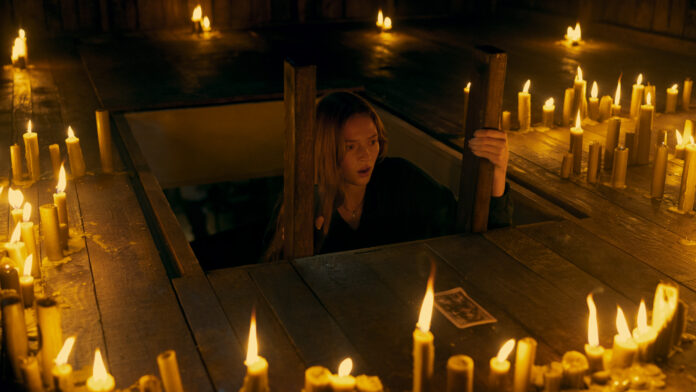When a group of friends recklessly violates the sacred rule of Tarot readings – never using someone else’s deck – they unknowingly unleash an unspeakable evil trapped within the cursed cards. One by one, they come face to face with fate and end up in a race against death to escape the future foretold in their readings.
“Tarot,” a film by Spenser Cohen & Anna Halberg, is presented by Screen Gems in association with Ground Control, and is an Alloy Entertainment production. The cast includes Harriet Slater, Adain Bradley, Avantika, Wolfgang Novogratz, Humberly González, Larsen Thompson, and Jacob Batalon. Spenser Cohen & Anna Halberg also serve as the writers and directors. Leslie Morgenstein, Elysa Koplovitz Dutton, and Scott Glassgold are the producers, with Andrew Pfeffer, Scott Strauss, Anna Halberg, and Spenser Cohen as executive producers. Elie Smolkin csc serves as the director of photography, Felicity Abbott as the production designer, and Tom Elkins, ACE as the editor. Ivana Vasic is the costume designer, with music by Joseph Bishara.
Anna Halberg, along with her writing and directing partner Spenser Cohen, shares, “Tarot cards and readings are inherently scary.” As they molded the narrative, Cohen discerns, “During moments of uncertainty— and let’s admit, uncertainty is a constant— individuals often seek refuge in tarot and astrology for clarity.” This realization leads them to probe the eternal question: are our destinies dictated by celestial alignments, or do we retain agency over our lives? “It’s a universally resonant theme,” Cohen emphasizes. “Yet, at its core, our film morphed into a tale of one woman’s confrontation with mortality – a journey of grappling with trauma and, ultimately, embracing liberation.”
Producer Scott Glassgold finds resonance in the storyline with one of humanity’s deepest anxieties – the unknowable nature of tomorrow. This fear renders it ripe for Cohen and Halberg’s horror narrative, particularly because, remarkably, tarot had remained largely unexplored in cinematic storytelling. “Tarot and astrology captivate me,” the producer reflects. “They offer glimpses into the enigmatic cosmos, illuminating pathways through the unknown. Their mystical essence inherently invites dread. The Major Arcana, with its rich cast of characters, provides a perfect springboard for chilling narratives. It’s exceedingly rare to encounter such a distinctive yet uncharted cinematic realm. Tarot presented a compelling opportunity to plunge into this vast, unexplored universe.”
In the film, characters explore their fortunes using a sophisticated zodiac spread: twelve cards arranged in a circle, with each card symbolizing a zodiac sign and conveying its own meanings – emotions, relationships, desires, aspirations. In the center of this circle lies a thirteenth card, symbolizing the overarching theme of the tarot spread, offering clarity to the other cards.
To animate the renowned tarot cards, Cohen and Halberg enlisted the talents of two artists: one tasked with designing the film’s monsters, and the other to reinterpret those designs into a cursed tarot deck. “When we decided to bring the tarot cards to life, we knew we had to present these iconic cards—The Magician, The Devil, Death—in a way that would evoke nightmares and be completely original,” explains Cohen. “We’re big admirers of Trevor Henderson, an incredible artist we follow on Instagram; we approached him and entrusted him with the sole design of all the creatures in the film. Once Trevor’s designs were finalized, our production designer, Felicity, discovered Richard Wells, a graphic designer who skillfully transformed Trevor’s concept art into these weathered, eerie-looking, handmade tarot cards featured in the film.”
After finalizing the monsters, the subsequent task was the creation of their deck. “By the time I came on board, Trevor Henderson had already completed the monster designs,” Wells elaborates. “My job was to capture the essence of his designs while adapting them to fit the format of tarot cards. For instance, with the Hermit card, this involved depicting a scene for the character, emerging from a tunnel while holding his lantern. In other instances, I added extra dramatic elements – like with the Death card, placing it amidst a landscape of skulls.”
For the tarot designs, Wells collaborated closely with Halberg and Cohen to craft original artwork that would mirror and hint at the film’s unfolding events. “The concept in the script was that the cards constitute a unique, handcrafted deck,” he explains. This idea also influenced the production process. “One challenge was to develop a style that could feasibly have been hand-painted on the small scale of a tarot card,” he remarks. Consequently, Wells created the card designs digitally, which were then scaled appropriately by the art department for a tarot deck and meticulously painted by hand to achieve the desired aesthetic.
The filmmakers discovered suitable filming locations in Serbia. “This afforded us the opportunity to shoot in extraordinary settings that we likely wouldn’t have access to elsewhere,” says Cohen. “We even closed down a bridge that resembled something out of a Mission: Impossible movie—it was that massive; it linked two parts of the country. Serbia’s enthusiasm for our presence enabled us to secure this unique filming opportunity.”
Another illustration of Serbia’s cooperation with the filmmakers is the train station scene. “Originally, we planned to shoot it on active train tracks, but shutting down the entire train system proved impossible,” explains Halberg. “Instead, we discovered a section of a recently completed train station that had yet to be fully utilized, and we secured it for a two-day shoot.”
“Tarot” has received a PG-13 rating from the Motion Picture Association for horror violence, terror, bloody images, some strong language, and drug content. The film is set to premiere in theaters nationwide on May 3, 2024.


